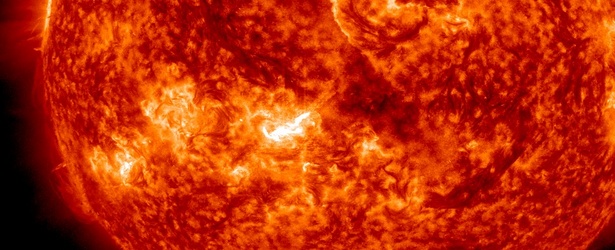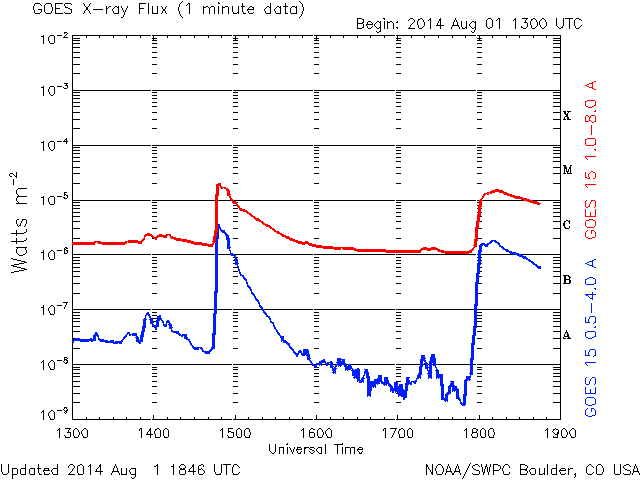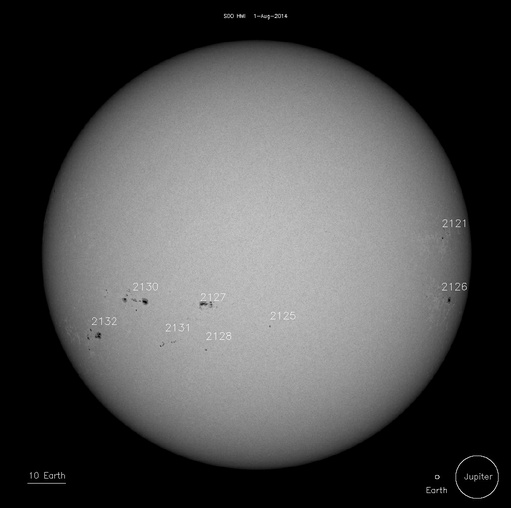Second M-class solar flare of the day – long duration M1.5 from Region 2127

A second M-class solar flare of the day erupted at 18:13 UTC. The source of this latest event was 'beta-gamma' classified Active Region 2127 capable of producing strong eruptions on the Sun. The event started at 17:55, peaked at 18:13 as M1.5 solar flare and ended at 18:48 UTC, almost a full hour.
This is now the third M-class solar flare in a row since M2.5 at 11:41 UTC on July 31, 2014.
A Type II and IV radio emissions were associated with the event. Type IV emissions occur in association with major eruptions on the sun and are typically associated with strong coronal mass ejections and solar radiation storms.
Region 2127 is located near the center of the disk which makes it more geoeffective than AR 2130, the source of previous two M-class solar flares (M2.5 and M2.0 at 14:48 UTC today).
NOAA SWPC forecasters estimate 40% chance for M-class, and 5% chance for X-class solar flare in the next 2 days.

Space Weather Message Code: ALTTP4
Serial Number: 468
Issue Time: 2014 Aug 01 1901 UTC
ALERT: Type IV Radio Emission
Begin Time: 2014 Aug 01 1818 UTC
Description: Type IV emissions occur in association with major eruptions on the sun and are typically associated with strong coronal mass ejections and solar radiation storms.
***
Space Weather Message Code: ALTTP2
Serial Number: 947
Issue Time: 2014 Aug 01 1900 UTC
ALERT: Type II Radio Emission
Begin Time: 2014 Aug 01 1818 UTC
Estimated Velocity: 563 km/s
Description: Type II emissions occur in association with eruptions on the sun and typically indicate a coronal mass ejection is associated with a flare event.
Sunspots
There are currently 8 numbered sunspot regions on the Earth side of the Sun.
Region 2132 continued to show signs of growth and was also responsible for several optical flares in last 24 hors. Region 2129 (S05W58, Bxo/beta) displayed spot reemergence from its previously reported plage status but has yet to produce significant flare activity. The remaining seven numbered sunspot groups were stable or in a state of slight growth during last 24 hours. (SWPC – August 1, 2014 @ 12:30 UTC)

Sunspots on August 1, 2014. Image credit: NASA SDO / HMI
2121 – Beta
2125 – Alpha
2126 – Beta
2127 – Beta-Gamma
2128 – Alpha
2130 – Beta-Gamma
2131 – Beta
2132 – Beta
Featured image: SDO AIA 304 on August 1, 2014 @ 18:00 UTC

Commenting rules and guidelines
We value the thoughts and opinions of our readers and welcome healthy discussions on our website. In order to maintain a respectful and positive community, we ask that all commenters follow these rules:
We reserve the right to remove any comments that violate these rules. By commenting on our website, you agree to abide by these guidelines. Thank you for helping to create a positive and welcoming environment for all.